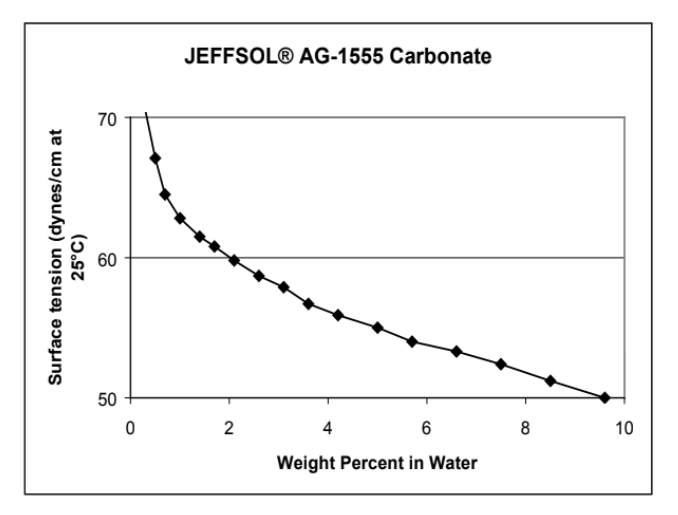Enhanced TDS
Identification & Functionality
- Agrochemical Functions
- Animal Feed & Nutrition Functions
- Blend
- No
- Chemical Family
- Chemical Name
- Product Code
- MITM11050
- Single Ingredient
- Yes
- Synonyms
- 1-Methylethylene carbonate, 1,2-Propanediol carbonate, 1,2-Propanediol cyclic carbonate, 1,2-Propanediyl carbonate, 1,2-Propylene carbonate, 2-Methyl-1,2-ethylene carbonate, 2-Oxo-4-methyl-1,3-dioxolane, 4-Methyl-1,3-dioxolan-2-one, 4-Methyl-1,3-dioxolane-2-one, 4-Methyl-2-dioxolanone, 4-Methyl-2-oxo-1,3-dioxolane, Arconate propylenecarbonate, Carbonic acid cyclic 1,2-propylene ester, Carbonic acid cyclic methylethylene ester, Cyclic 1,2-propylene carbonate, Cyclic methylethylene carbonate, Cyclic propylene carbonate, Methyl-1,3-dioxolan-2-one, Propylene glycol cyclic carbonate
- Technologies
- Product Families
Features & Benefits
- Agrochemicals Features
- Labeling Claims
- Product Benefits
- High Solvency
- Low toxicity
- Low odor
- High boiling point
- High flash point
- Low evaporation rate
- Low vapor pressure
- Readily biodegradable
- VOC Exempt in U.S.
Applications & Uses
- Markets
- Applications
- Product Applications
- Solvent for pesticide formulations
- Veterinary topical formulations
- Component of tank adjuvants
- Minimal risk solvent
Properties
- Physical Form
Safety & Health
- Safety Information
- JEFFSOL® AG-1555 carbonate may be satisfactorily stored in carbon steel or stainless steel tanks using steel pipes and pumps.
- Because of the decomposition potential of carbonates, the tanks should be equipped with pressure relief devices and have an inert gas pad.
- Satisfactory pump gasket materials include TEFLON® fluoropolymer, EPR, neoprene, natural rubber, cork and polyethylene.
- Unsatisfactory gasket materials are BUNA N, HYPALON® chlorosulfonated polyethylene and VITON® fluoroelastomer.
Biodegradability and Environmental Safety:
- Recent studies indicate that JEFFSOL® AG 1555 carbonate is very readily biodegradable.
- Values of up to 90% of Theoretical Oxygen Demand (ThOD) are obtained after 15 days at typical concentrations normally observed in waste water treatment plant and higher levels (250-2500 mg/l). Other recent studies indicate biodegradation of >90% after 28 days.
- JEFFSOL® AG-1555 carbonate is practically nontoxic to rats by a single oral exposure or to rabbits by a single dermal exposure.
- This product is minimally irritating to the eyes and skin of rabbits and did not produce dermal sensitization in laboratory animals.

Hansen Solubility Parameter (cal¹/² cm-³/²)
Total 13.3 Dispersive 9.8 Polar 8.8 Hydrogen bonding 2.0 Dipole moment (Debeyes 40°C) 4.98
Packaging & Availability
- Packaging Type
Principal Information
- Group Principal Number
- S001767
- Principal
Storage & Handling
- Storage Conditions
- JEFFSOL® AG-1555 should retain its conformance to sales specifications for a period of at least two years from date of manufacture if the product is stored at less than 100°F (37.8°C) in its undamaged, unopened, factory packaged container.
- In general, the user should determine the suitability of any chemical compound, no matter what the shelf life or length of time of storage.
- Each user should conduct a sufficient investigation to establish the suitability of any product for his intended use.
Other
- Appearance
- Clear and substantially free
- Appearance (SDS)
- Liquid
- Color (SDS)
- Colorless
- Item Number
- Odor (SDS)
- Slight
- Other Hazards
- None known
- USA/DOT UN Number
- Not Applicable
- Optical Properties
Value Units Test Method / Conditions Color Scale max. 40.0 Pt-Co Pt-Co - Shelf Life & Stability
Value Units Test Method / Conditions Shelf Life 2.0 yr yr - Physical Properties
Value Units Test Method / Conditions Boiling Point 242.0 °C °C Density 10.1 lb/gal lb/gal At 20°C Evaporation Rate max. 0.005 % % at 25°C Flash Point 135.0 °C °C Pensky-Martens Closed Cup (PMCC) Kinematic Viscosity 2.1 cSt cSt At 25°C Kinematic Viscosity 1.6 cSt cSt at 43.3°C Melting Point -48.0 °C °C Vapor Pressure 0.03 mm Hg mm Hg At 20°C - Material Composition
Value Units Test Method / Conditions Propylene Carbonate Content min. 99.7 %(W/W) %(W/W) Gas Chromatography water free, w/w Propylene Carbonate Content min. 99.7 %(W/W) %(W/W) Internal Method - SDS Physical and Chemical Properties
Value Units Test Method / Conditions Autoignition Temperature (SDS) 430.0 °C °C Boiling Point (SDS) 242.0 °C °C Density (SDS) 1.2 g/cm³ g/cm³ at 25°C Evaporation Rate (SDS) max. 5.0 % % Flammable Limits (SDS) 4.7 %(V) %(V) Flash Point (SDS) 135.0 °C °C Pensky-Martens Closed Cup (PMCC) Kinematic Viscosity (SDS) 1.6 mm²/s mm²/s at 43.33°C Log Partition Coefficient (Log Pow) (SDS) -0.5 - at 20°C, n-octanol/water, Log pow Melting Point (SDS) -49.0 °C °C Molecular Weight (SDS) 102.09 g/mol g/mol Relative Density (SDS) 1.2 - Relative Vapor Density (SDS) 3.5 - Solubility In Water (SDS) 200.0 g/L g/L at 25°C Upper Flammable Limit (SDS) 21.0 %(V) %(V) Vapor Pressure (SDS) 0.030659 hPa hPa At 20°C Viscosity (SDS) 2.5 mPa.s mPa.s at 25°C pH (SDS) 7.0 -
